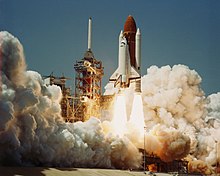Space Shuttle Challenger
| Challenger OV-099 |
|
|---|---|

Challenger is launched on its first mission, STS-6
|
|
| OV designation | OV-099 |
| Country | United States |
| Contract award | January 1, 1979 |
| Named after | HMS Challenger (1858) |
| Status | Destroyed January 28, 1986 |
| First flight |
STS-6 April 4–9, 1983 |
| Last flight |
STS-51-L January 28, 1986 |
| Number of missions | 10 |
| Time spent in space | 62 days 07:56:22 |
| Number of orbits | 995 |
| Distance travelled | 25,803,939 mi (41,527,414 km) |
| Satellites deployed | 10 |
Space Shuttle Challenger (Orbiter Vehicle Designation: OV-099) was the second orbiter of NASA's space shuttle program to be put into service following Columbia. The shuttle was built by Rockwell International's Space Transportation Systems Division in Downey, California. Its maiden flight, STS-6, started on April 4, 1983. It launched and landed nine times before breaking apart 73 seconds into its tenth mission, STS-51-L, on January 28, 1986, resulting in the death of all seven crew members, including a civilian school teacher. It was the first of two shuttles to be destroyed in flight, the other being Columbia in 2003. The accident led to a two-and-a-half year grounding of the shuttle fleet; flights resumed in 1988 with STS-26 flown by Discovery. Challenger itself was replaced by Endeavour which was built using structural spares ordered by NASA as part of the construction contracts for Discovery and Atlantis.
Challenger was named after HMS Challenger, a British corvette that was the command ship for the Challenger Expedition, a pioneering global marine research expedition undertaken from 1872 through 1876. The Apollo 17 lunar module that landed on the Moon in 1972 was also named Challenger.
Because of the low production volume of orbiters, the Space Shuttle program decided to build a vehicle as a Structural Test Article, STA-099, that could later be converted to a flight vehicle. The contract for STA-099 was awarded to North American Rockwell on July 26, 1972, and its construction was completed in February 1978. After STA-099's rollout, it was sent to a Lockheed test site in Palmdale, where it spent over 11 months in vibration tests designed to simulate entire shuttle flights, from launch to landing. In order to prevent damage during structural testing, qualification tests were performed to a factor of safety of 1.2 times the design limit loads. The qualification tests were used to validate computational models, and compliance with the required 1.4 factor of safety was shown by analysis. STA-099 was essentially a complete airframe of a Space Shuttle orbiter, with only a mockup crew module installed and thermal insulation placed on its forward fuselage.
...
Wikipedia
